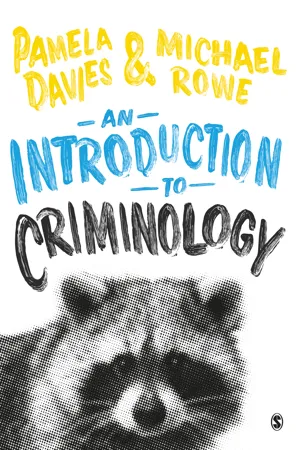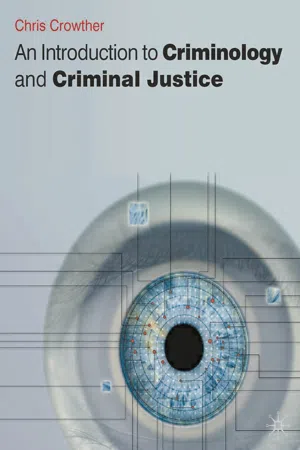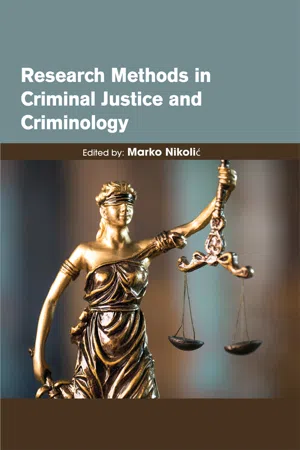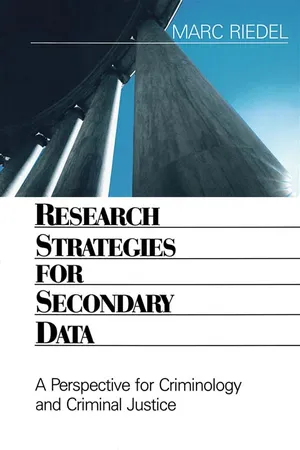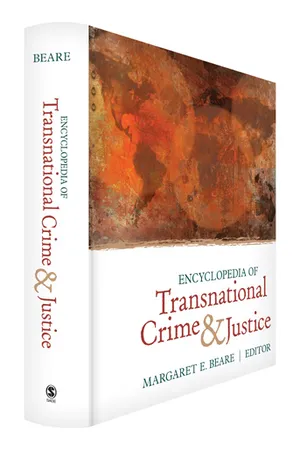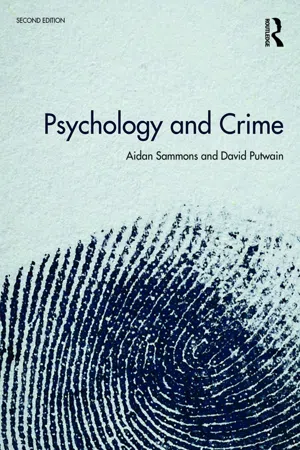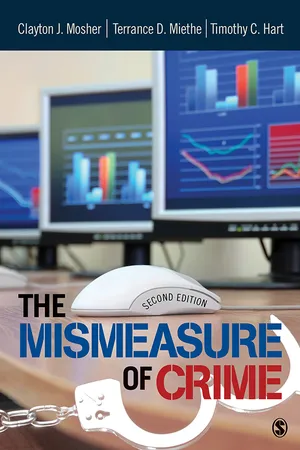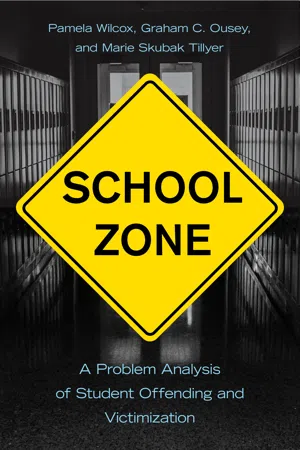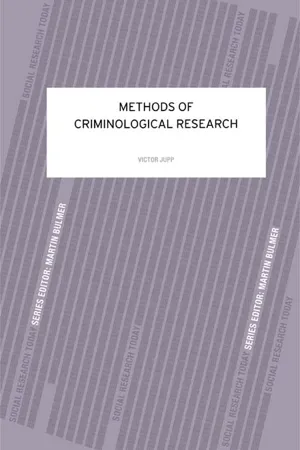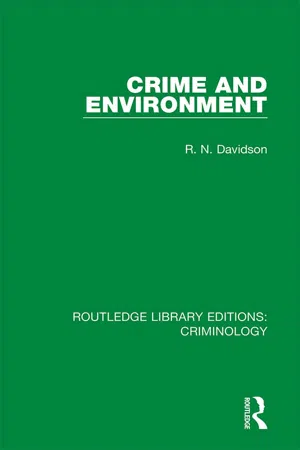Social Sciences
Data on Crime
Data on crime refers to statistical information collected and analyzed to understand the prevalence, nature, and patterns of criminal activities within a specific population or geographic area. This data is crucial for informing public policy, law enforcement strategies, and crime prevention initiatives. It often includes details such as types of crimes committed, demographics of offenders and victims, and trends over time.
Written by Perlego with AI-assistance
Related key terms
1 of 5
11 Key excerpts on "Data on Crime"
- eBook - PDF
- Shlomo Giora Shoham, Paul Knepper, Martin Kett(Authors)
- 2010(Publication Date)
- Routledge(Publisher)
All data collectors, including police offi cers, researchers, victims, and offenders, must use their knowledge and discretion in order to decide whether a given action is a crime in a strictly legal sense. Crime data, be they offi cial statistics or from self-report or victimization surveys, are not facts that necessarily reflect real-life events. Although statistics is defined as “the collection and arrangement of numerical facts or data” and data is defined as “a thing given or granted; something known or assumed as fact” [ OED Online, 2009] statistics are, in fact, products . Any data generated by the police or a survey should be treated as a subjective measure of a social process [Coleman and Moynihan, 1996:82]. Major contributors to the misunderstanding and misuse of crime statistics and crime survey data are “the two related assumptions that there is an objective definition of the The Politics of Numbers 137 crime problem and that a statistical system can assess this problem without distortion” [Lynch and Addington, 2007:7]. One major problem with using crime statistics as a source of crime knowledge is chronic underreporting (the dark figure). Underreporting disturbs the usefulness of gathered data for the overall composition, level, and trends in crime. Both victimization surveys and self-report surveys are ex post uncoverings of crimes unreported by either victims or offend-ers [Coleman and Moynihan, 1996]. Levels of reliability and validity vary according to the type of crime, offender, or victim being explored in different aggregated crime data. No available crime statistics, whether offi cial or from self-report studies or crime surveys, give the whole picture; but used with caution, all three types of sources shed light on some of the picture. Until now, we have mainly treated various crime statistics as a source of knowledge in criminology. - eBook - ePub
- Pamela Davies, Michael Rowe, Pamela Davies, Michael Rowe(Authors)
- 2021(Publication Date)
- SAGE Publications(Publisher)
historical period, season and time of the day), personal (including development and socialisation), and environmental (for example, geography, community, place and circumstances) factors, and therefore entails to a larger or smaller extent a degree of randomness. Secondly, what is deemed as crime has also evolved over the years and differs considerably across societies. To complicate matters further, the prevailing view in a given society of what constitutes extremely unacceptable and punishable acts, and what is illegal according to the laws of the jurisdiction within which this same society operates, may diverge. Knowledge link: This topic is also covered in Chapter 2. Before proceeding we need to introduce accurately the term ‘data’ which, as a familiar everyday word, might be prone to misinterpretation. The tools for measuring anything, including crime, are known as data: ‘“facts and statistics collected together for reference or analysis’ and ‘things known or assumed as facts, making the basis of reasoning or calculation’ according to the Oxford English Dictionary (https://www.lexico.com/en/definition/data accessed 04.11.2019). The main sources for measuring crime are police records and surveys. Figure 4.2 delineates how much of place- and time-specific crime can be measured by these two sources. Good police and survey data evolve to follow and reflect society’s notion of crime. Survey-based crime statistics ideally enable comparisons with police statistics whilst incorporating tools for mapping it on existing legal definitions - Chris Crowther-Dowey(Author)
- 2017(Publication Date)
- Red Globe Press(Publisher)
PART TWO Understanding Crime Data INTRODUCTION This chapter introduces students to the two main types of crime data, quantitative and qualitative. It shows that these can give very different impressions of crime and its impact. It is often argued that the two are incompatible, but the overarching aim of the chapter is to show that they may be integrated effectively and used to complement each other. Perhaps the first point to make is that this chapter is concerned with the data itself and not the research methods criminologists use to get hold of data. The ways in which information is collected are examined in Chapter 4. The purpose of this chap-ter is therefore restricted to briefly introducing different types of data to show how they contribute to our understanding of crime, disorder and victimization. After a Understanding Crime Data I: Sources of Information 3 OVERVIEW The aim of this chapter is to: ឣ explain the importance of having sound information about crime ឣ discuss different types of crime data, paying attention to the differences between quantitative and qualitative sources of information ឣ provide an understanding of the relative strengths and weaknesses of qualitative and quantitative data ឣ give a basic introductory overview of official sources of crime data, including recorded crime statistics and the British Crime Survey ឣ consider the relevance of social divisions for understanding crime data ឣ provide a case study focusing on the quantifiable costs of anti-social behaviour and the relative merits and demerits of this type of information. brief outline of what is meant by quantitative and qualitative data, two of the main sources of crime data are identified, recorded crime statistics and the British Crime Survey (BCS). These two data sources may be categorized as official information, and it is shown that they tend to prefer quantitative data. The strengths and weaknesses of this type of data are rehearsed.- Marko Nikolic(Author)
- 2019(Publication Date)
- Society Publishing(Publisher)
10.1. INTRODUCTION The data collection of crimes by sociologist Émile Durkheim in the 1897 gave rise to the various sources of Data on Crimes and at that time the information is seen in quantitative form of suicide rates across different populations. In the 20th century there is large change in sources of Data on Crimes. There are various premises and theories associated to tendency of criminal behavior and it must undergo test to establish it and it is developed on the data from recorded convictions, environment, and social experiences and it is used as base in the year of 1915. There is rich amount of criminology theories that got developed by social scientists of British origin in quantitative form, and from the 1950 the steps to document the crime is taken by many criminology experts as stated by experts in year of 2000. There is rapid advancement that has taken place in the technology and it has opened the new doors of data collection and analytical methods, many of the old sources and measures have been altered or have persistent to be used in one shape or another till now. In the last few decades, the experts have presented the idea of many sources of measuring crimes. There has been no attempt made by sociologists in all these years of a broad level assessment and evaluation of the data sources to find out what is most beneficial for measuring crime. There should be established practice of using accurate crime data source to satisfactorily make firm conclusion and it should have been done Evaluation of Crime and Criminology Research 207 very much before to know the status of crime if it has been increasing or decreasing. 10.2. MAJOR SOURCES OF CRIME DATA To assess the crime, the different type’s data sources have developed over the years. There are different advantages and disadvantages of each source.- eBook - PDF
Research Strategies for Secondary Data
A Perspective for Criminology and Criminal Justice
- Marc Riedel(Author)
- 1999(Publication Date)
- SAGE Publications, Inc(Publisher)
1 SECONDARY DATA IN CRIMINOLOGY AND CRIMINAL JUSTICE P eople who do research on crime depend heav-ily on secondary data—defined here as the use of statistical material and information originally gathered for an-other purpose. 1 Crime researchers 2 use information from the Bureau of the Census, National Crime Victimization Survey (NCVS), 3 Na-tional Center for Health Statistics (NCHS), 4 Uniform Crime Report-ing (UCR) 5 program, and sample surveys done by other people as sec-ondary data sources. In addition, crime researchers assemble research data sets from the official records of police departments, juvenile and adult courts, detention centers, community treatment agencies, probation and parole offices, and prisons. In an effort to learn what types of data are used by crime research-ers, I did an informal survey of the types of data used by two major journals, Justice Quarterly and Criminology, for the period 1992 through 1996. The results are given in Table 1.1. 1 2 RESEARCH STRATEGIES FOR SECONDARY DATA TABLE 1.1 Types of Data Used in Justice Quarterly and Criminology Articles: 1992-1996 Percentage Percentage Number of Percentage Primary Secondary Percentage Articles No Data Data Data Combination Justice Quarterly 141 14.9 39.7 29.8 15.6 Criminology 131 19.2 17.6 56.2 8.5 Each article for the 5-year period was classified into four catego-ries, excluding book reviews. No Data refers to articles, such as theoretical articles, in which research was cited but there was no indi-cation of analysis or manipulation of data. Primary Data means data gathered by the authors using interviews or survey methods. Secondary Data, defined previously, includes archival data, sur-veys, official records, and official statistics. Combination refers to articles that use a combination of primary and secondary data. Table 1.1 shows that, among all published articles in the two jour-nals, secondary data are more frequently used in Criminology (56.2%) than in Justice Quarterly (29.8%). - Margaret E. Beare(Author)
- 2012(Publication Date)
- SAGE Publications, Inc(Publisher)
This comparison can be more telling than simply referring to the published data, because there can be no bias in the comparison. Another valuable tool in research is the ability to compare newly collected data (secondary data) with previ-ously collected data (primary data). There are two ways in which this approach can help: First, primary data can confirm newly found data, and second, dif-ferences in the data can point out problematic areas. Data exchange can occur between nations. Data of this type are typically census data or other governmentally collected data. Exchange can also occur between regions, states, and municipalities to improve social problems or just display differences. Temporal data analysis is vital to our understanding of the world we live in and where we are headed. Data collected over time can provide researchers with infinite amounts of data that can aid in an equally large number of studies. Of course, there are challenges associated with measuring data in criminology. A number of variables influence police to record a crime or make an arrest. For example, an assault between people who know each other will less likely be recorded than a fight between two strangers. Also, there will be times when the victim will urge the police not to press charges on the offender or even not arrest that person. Another measurement challenge results from when laws change. There are different laws in effect in different jurisdictions, and laws often vary from country to country. Measuring and Categorizing Data Empirical data can be measured or categorized. If we measure data, we are assigning them quantities related to their attributes (attitudes); if we categorize them, we put them in the same or different catego-ries with respect to a given attribute (classification). The research objects in criminology are usually people, their acts, or sometimes physical objects and people’s relationships to them.- eBook - PDF
Psychology and Crime
2nd edition
- Aidan Sammons, David Putwain(Authors)
- 2018(Publication Date)
- Routledge(Publisher)
chapter 2 Defining and measuring crime 11 (see Chapter 8). An associated claim is that the excess of crime among black males is accounted for by the types of ‘victimless’ crime (e.g. possession of drugs) where the authorities have more discretion about who to arrest, investigate and charge. Critical perspectives on race, ethnicity and crime are explored in Chapter 12. Measuring crime Just as it may seem simple at the outset to define what a criminal is, it might also seem relatively straightforward to measure how much crime there is. Surely it is just a matter of counting how many crimes occur? Again, matters are not so sim-ple. The crime rate of a given country or area is calculated by counting how many offences occur and dividing by the number of people who live there. The problem is that there are several ways of counting crimes and they tend not to agree with one another. The three main sources of information about the extent of crime are offi-cial statistics, victimisation surveys and offender surveys. Each of these sources of information has its strengths and limitations but all of them distort the ‘true’ figure of crime to some extent. Apply your learning Two candidates are standing for election as local police commissioner. The current commissioner is campaigning on the basis that her policies have resulted in a low level of crime. The challenger is campaigning on the basis that crime is ‘out of control’ in the locality. How might each justify their campaign position? How might each criticise their opponent’s stance? Official crime statistics In England and Wales, official crime figures are published by the Office for National Statistics (ONS) on the basis of two sets of data, the crimes recorded by the police and a victimisation survey now known as the Crime Survey for England and Wales (CSEW). Similar arrangements are in place in Scotland and Northern Ireland. - eBook - ePub
- Clayton J. Mosher, Terance D. Miethe, Timothy C. Hart(Authors)
- 2010(Publication Date)
- SAGE Publications, Inc(Publisher)
In this chapter, we discuss the development of statistics on crime, both cross-nationally and historically. We first address official statistics on crime, examining their sources and how they were often used uncritically by social scientists and individuals who wrote articles in the popular media to comment on crime and its causes. We then move to a discussion of how a growing realization of the inadequacies of these official statistics led to the development of alternative measures of crime and delinquency. Several social scientists became concerned about how official crime data were generated, noting that uncritical analyses of these statistics could result in misleading conclusions regarding the causes of crime. In particular, they noted problems related to the so-called dark figure of crime, that is, crimes committed by individuals that were not recorded in the official data. These concerns led first to the development of self-report studies of deviant and criminal behavior in the 1940s, followed by the emergence of victimization studies in the 1960s. The development and use of these alternative measures of crime led to important theoretical and policy debates within the discipline of criminology and, some would argue, to a fundamental shift in the focus of criminology as a discipline.THE EARLY HISTORY OF MEASURING SOCIAL PHENOMENA AND CRIMENumber, weight, and measure are the foundations of all exact science; neither can any branch of human knowledge be held advanced beyond its infancy which does not, in some way or other, frame its theories or correct its practice by reference to those elements. What astronomical records or meteorological registers are to a rational explanation of the movement of the planets or of the atmosphere, statistical returns are to social and political philosophy. They assign, at determinate intervals, the numeric values of the variables which form the subject matter of its reasonings, or at least of such “functions” of them as are accessible to direct observation; which it is the business of sound theory so to analyze or to combine as to educe from them those deeper seated elements which enter into the expression of general laws. (Herschel, as cited in Duncan, 1984, p. 97) - eBook - PDF
School Zone
A Problem Analysis of Student Offending and Victimization
- Pamela Wilcox, Graham C. Ousey, Marie Skubak Tillyer(Authors)
- 2022(Publication Date)
- Temple University Press(Publisher)
Included in the discussion are the fol-lowing datasets: the National Crime Victimization Survey’s (NCVS) School Measuring School Crime / 43 Crime Supplement (SCS), the Centers for Disease Control and Prevention’s Youth Risk Behavior Surveillance System (YRBSS), the National Study of Delinquency Prevention in Schools (NSDPS), the U.S. Department of Edu-cation’s School Survey on Crime and Safety (SSOCS), the National Longitu-dinal Study of Adolescent to Adult Health (Add Health), the National Edu-cation Longitudinal Survey (NELS:1988), and the Education Longitudinal Study of 2002 (ELS:2002). 1 These studies are national in scope; each is de-signed for a specific purpose. They differ in terms of the variables they mea-sure, and in their measurements of school crime. Therefore, we do not rely on a single data source to learn about how and why experiences with school crime and safety vary across people, places, and times. Collectively, these national studies provide valuable information on the nature of crime in schools in the United States. For example, the sampling methodologies used in many of these studies have produced nationally representative samples, allowing researchers to estimate the prevalence of school crime. In addition, studies that have collected data across multiple years allow the observation of changes in school crime trends over time. The downside of these national data sources is they typically do not measure some of the key explanatory factors underlying the crime expla-nations outlined in Chapter 2. Thus, our ability to test potential explana-tions of variation in school crime across people, places, and times with the national data sources is limited. Therefore, researchers also rely on addi-tional data sources to examine why school crime varies across people, plac-es, and times. These additional data sources include information collected from subnational samples, often within a single state, school district, or school. - eBook - ePub
- Victor R Jupp(Author)
- 2012(Publication Date)
- Routledge(Publisher)
meaning , that is, to the meaning which unemployment has for the individuals concerned. Correlations between unemployment and crime at whatever level are not in themselves adequate. What is missing is some theoretical explanation of the relationship in terms of the subjective significance which unemployment has for some individuals which leads them to criminal actions. In this way criminal actions are rendered intelligible in terms of unemployment and what it means for the individuals concerned. The problem of meaning is primarily the domain of qualitative research, which is discussed in the following section.Explaining crime: qualitative research
Nature of qualitative research
In the preceding chapter qualitative data were described as those forms of data collected about the social world which are not set in numerical terms. Qualitative research is research which seeks to collect such data and as such is a very broad and general category which encompasses a wide range of research activities and styles. In this section we are specifically concerned with qualitative research which is in the ethnographic tradition and which gives primacy to descriptions and explanations which are derived from data collected about the actor’s point of view of his or her social situation. This research style gives particular emphasis to uncovering social meanings, definitions, stereotypes, typifications and labels, and data are collected by a range of methods which include participant observation and detailed interviews. Discussion of such qualitative research will take place in connection with studies which are concerned with those propositions elaborated earlier which locate crime in the context of schooling, parenting and youth culture.Early exponents of ethnographic work were the Chicagoans who integrated observational and life-history studies into quantitative ecological research. More recently, qualitative research has been associated with the influence of micro-sociological theories in the study of crime. Such qualitative research flourished in the 1970s as part of the onslaught on positivist explanations of crime and criminality. The micro-sociological framework includes different theoretical strands and influences many of which overlap. Bryman (1988) distinguishes such strands. These are phenomenology , which is influenced by the writings of Alfred Schutz and is concerned with the everyday constructs which individuals use to make sense of their world; ethnomethodology , which owes much to Harold Garfinkel and which focuses on the methodologies or strategies of practical reasoning used by everyday people; symbolic interactionism , derived from the social psychological work of George Herbert Mead, and concerned with social meanings and their generation and modification in processes of interaction; verstehen ,which is founded upon Weber’s edict to seek subjective understanding of actions and to make explanations adequate at the level of meaning; naturalism , and the emphasis upon observing and recording actions as they normally occur and in the natural setting and contexts in which they occur; and ethnogenics - eBook - ePub
- R. N. Davidson(Author)
- 2019(Publication Date)
- Routledge(Publisher)
4 CRIME AND THE COMMUNITYThe fact that some parts of cities suffer much more crime than others is no news to most urban dwellers. The evidence is all too obvious: graffiti, vandalism, the armoured shop-fronts, the wail of police sirens all point to the ‘criminal areas’. But to what extent do these reflect the real distribution of crime? Few of us will have been victims for crime is still a rare event so we base our perceptions on other sources than our direct experience. The last three chapters have been largely concerned with the evidence of official statistics. How does this relate to the real distribution of crime? The interrelatedness, in a community context, of myths, perceptions and realities of crime and the reactions to it are the themes of this chapter. First, however, the significance of recorded crime must be assessed to establish its relevance, if any, to a community-based understanding of crime patterns.The Production of Official Crime Rates
Studies based on officially-recorded crime suffered a number of swingeing attacks in the 1960s and early 1970s. The basis for these attacks was the observation that the police have considerable discretion in the acceptance of an incident as violating the criminal code and in methods of identifying suspects (for example Banton, 1964; Wilson, 1968). So definitions of crime could be regarded as products of police procedures rather than of the criminal statutes. At the same time, the extent of unreported or undetected crime which evaded the sanctions of the law was being increasingly emphasised.The criticisms followed two main perspectives. Labelling theorists (for example Becker, 1963; Matza, 1964, 1969; Lemert, 1967) focused attention on the means by which definitions of deviant behaviour are achieved by the various agents of the crime control system. Deviancy is not a quality of the act or actors but an imposition by those delegated to circumscribe it. Alternatively, deviant definitions are located in the transactions between the controllers and the controlled (see, for example, Sacks, 1972). In either event studies based on officially-recorded crime were regarded as highly suspect (Kitsuse and Cicourel, 1963). Crime rates reflect not the incidence of crime in an area but the degree of police activity which will vary according to the subjective assessments of the policeman. Hence the proposition that patterns of recorded crime are a consequence of differential policing (Wiles, 1975).
Index pages curate the most relevant extracts from our library of academic textbooks. They’ve been created using an in-house natural language model (NLM), each adding context and meaning to key research topics.

